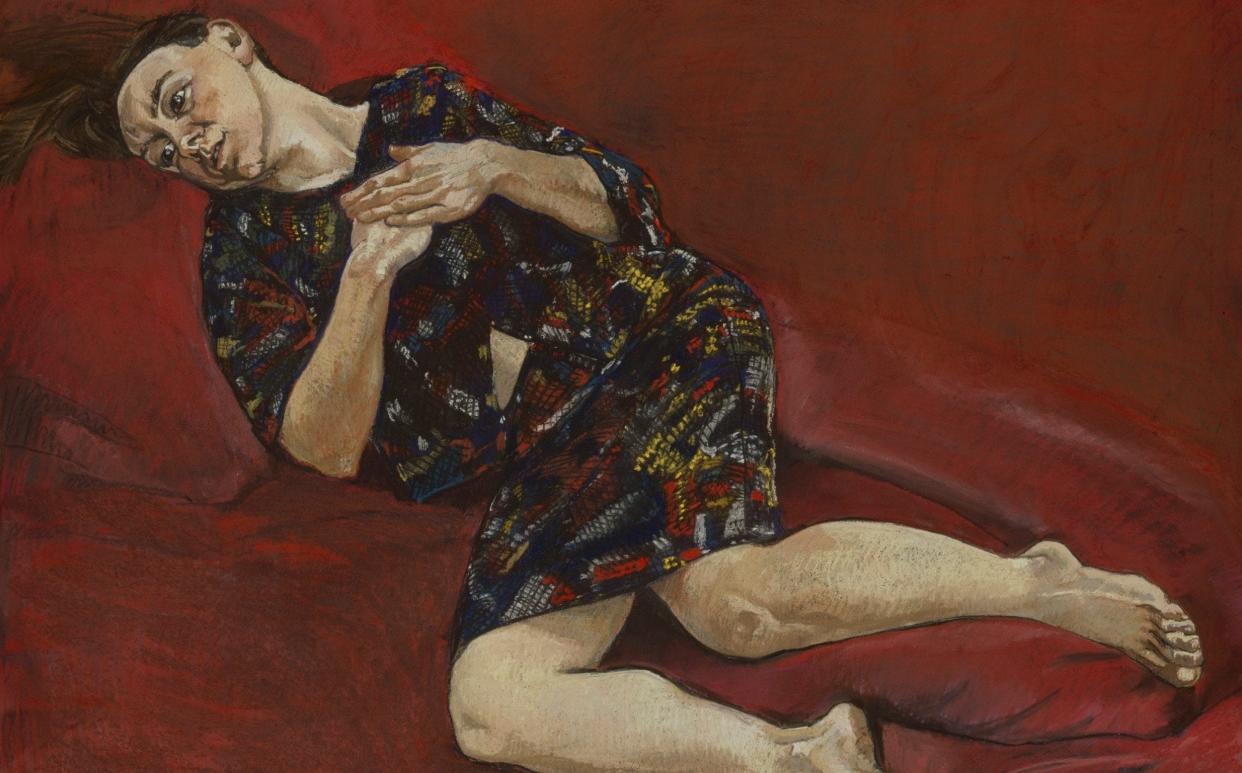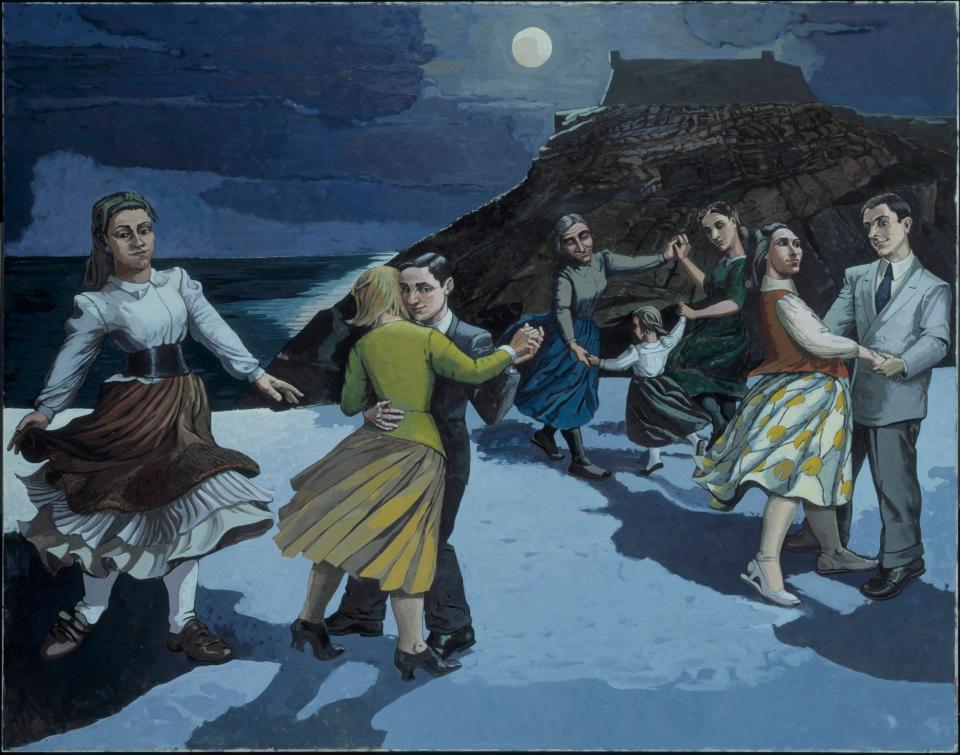Tate Britain repositions Paula Rego as a fierce deity for the Me Too generation

- Oops!Something went wrong.Please try again later.
Sugar and spice and all things nice: that, according to the 19th-century nursery rhyme, is what little girls are made of. Not the stubborn “senhoritas” in Paula Rego’s paintings, now on display in Tate Britain’s new survey of her work. No, they’re stocky little devils in party frocks, these wicked children, driven by rebellious instincts, thwarted sexual urges, and murderous impulses.
Here’s one, about to strangle her pet dog – a surrogate for the Portuguese artist’s husband, the British painter Victor Willing, who suffered from multiple sclerosis and died in 1988. There’s another, doing something obscene to her daddy’s leather boot. A third sits poised to pluck a floppy-necked dead goose. Presumably, she’s just delivered the coup de grace.
And pity the poor father in “The Family” (1988), forcefully undressed by his female kin in the marital bedroom: he only wanted to freshen up before dinner. At the window, a little girl clasps her hands, sensing imminent violence. Is she praying for the paterfamilias? Or cracking her knuckles in anticipation of a torture-fest? Payback time, daddy.
It must be the latter, if Tate’s repositioning of Rego as a fierce tutelary deity for the Me Too generation is to be believed. In this version of events, Rego, who was born in Lisbon in 1935 during a military dictatorship, has a black-and-white worldview in which men are the enemy, every single one, abusing women, controlling and manipulating them, denying their natural desires. In the ancient battle of the sexes, she is a five-star general, an Amazonian queen, feminism’s avenging angel.
There are series here protesting Portugal’s formerly repressive abortion laws and female genital mutilation. Even the earliest painting on display, “Interrogation” (1950), produced when Rego was 15 years old, features a seated woman, clutching her head in despair, flanked by uniformed thugs visible only from the waist down. Their bulging crotches suggest that she’s in danger. It’s a manifesto as much as a canvas, this picture – and ever since, over seven decades, Rego, who studied at the Slade in London and has lived in Britain since 1972, has been fighting the good fight. How best to describe the expression of the indomitable woman in a tunic as shiny as a breastplate who’s brandishing a sword in “Angel” (1998), a quasi-self-portrait, and one of Rego’s most celebrated works? She’s smiling, yes, but hardly simpering. To male viewers, that cold-as-ice countenance conveys this chilling message: “I’m coming for you.”

I wonder to what extent responses to Rego’s work, which perpetually demonises blokes as bogeymen, are determined by gender. As for Tate’s suggestion that “full recognition” for Rego has been “belated”, isn’t that a bit of a straw man? Throughout my adult life, at least, she’s been a dominant figure within British art. Two years ago, another substantial touring retrospective of her work opened in Milton Keynes.
Still, even if, like me, you’re not Rego’s biggest fan (I find her work, which relies upon literature, excessively illustrative and didactic), you must concede that this is an excellent exhibition: when Tate decides to roll out the red carpet for an artist, it does so with aplomb. Like the brilliant 2017 Hockney retrospective, also at Millbank, the show elegantly slices up its subject’s career into sleek, self-contained sections: visceral early political protests, raucous collages from the Sixties and Seventies, a return to painting in the Eighties. And then, for me, the show’s piece de resistance: a stunning room that reunites a series of monumental, enigmatic paintings which Rego showed to acclaim at the Serpentine in 1988, featuring those psycho-girls, as sneaky and resolute as resistance fighters. Suffused with soft, buttery light, but laced with menace, they will never look better.
While Rego’s lifelong crusade against “injustice”, as a wall text puts it, is irrefutable, there should have been greater emphasis on her biggest influence: the dark, twisted cruelty of nursery rhymes and fairy tales. For Rego, every child’s fear of monsters under the bed – the niggling sense that something warped and ugly is lurking behind the wainscot – is a source of considerable artistic power. Strange, malformed sprites and halflings throng her art, like escapees from the marginalia of medieval manuscripts, or the bat-winged freaks of her lodestar, Goya. As the years go by, though, she starts to over-stuff her compositions with dense imagery, each additional figure and object freighted with personal, sequestered significance, until they groan under the weight: “The Barn” (1994), for instance, is a silly, incoherent painting. Frequently, she tells us too much, while the insistence upon Jungian archetypes, reflecting her own long experience of therapy, now feels like a peculiar 20th-century quirk.
Still, who’d go mano-a-mano with such a red-blooded artist, who switched from paint to pastel during the Nineties because, as she once said, “the stick is fiercer, much more aggressive” than the brush? In a 1993 self-portrait, Rego smokes a pipe while “manspreading” in the middle of her studio: come and have a go if you think you’re hard enough. Even if, by her own admission, she’s most talented as a draughtsman and printmaker, she’s not going anywhere. Who’s going to make her?
From July 7 until Oct 24; information: tate.org.uk 0207 887 8888

